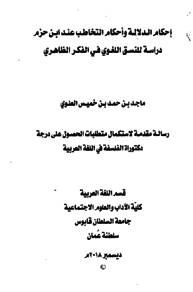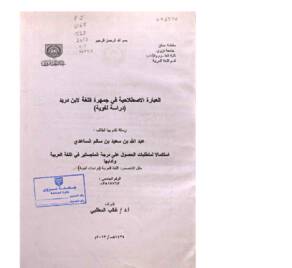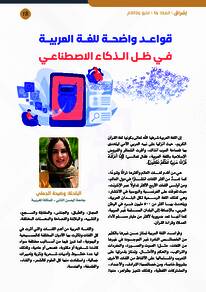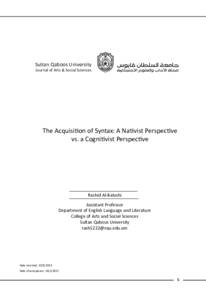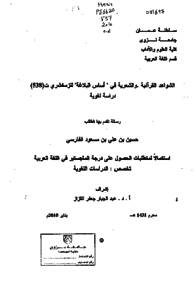Document
أحكام الدلالة و أحكام التخاطب عند ابن حزم : دراسة للنسق اللغوي في الفكر الظاهري
Publisher
جامعة السلطان قابوس
Gregorian
2018
Language
Arabic
English abstract
This study is on connotation ruling and pragmatics in Ibn Hazm's writing. It follows a comparative, analytical and descriptive methodology. It used pragmatics for revealing the linguistic order of the apparentness thinking. The two most important linguistic components of the apparentness order are the connotation and pragmátics where many elements integrate with each other to form a linguistic order that encounter some modern usages which concern in the first place with the way the meaning is discerned and the purposes. The problem this study deals with is how the lingual structure unifies with the usage by investigating in the distinction between language and its usage in apparent pragmatics. What are the basis of such distinction? What are the rules that control connotation? And what are the pragmatics' rules of apparentness thinking? There is interesting relationship in the textual applications of Ibn Hazm suggesting structural immanence in the thinking of apparentness thinking. However, this immanence is not consistent with the knowledge system in the Islamic culture which believes that the most important feature of the religious text is that it fits all times and places. So how can we explain a thinking that believes in such a fact, but relies on finite structure in its connotations?
This study reveals this problem in its results which show that the apparentness order emphasizes that each expression has its own meaning that control the connotation firmly. But when the meaning conflict with the logical and pragmatics rules for a reason or purpose, then the text's meaning shall comprehend more than what is understood from its apparent language. In this case, Ibn Hazm's deductive methodology can be briefed by the three following methods: understanding expression's commons, application of rules and connotation.
Description
رسالة جامعية
Member of
Resource URL
Arabic abstract
تناولت هذه الدراسة موضوع: إحكام الدلالة وأحكام التخاطب عند ابن حزم بمنهج تخاطبي (تداولي بغية الكشف عن النسق اللغوي للفكر الظاهري من كتاب الإحكام في أصول الأحكام، فأهم مكونين لغويين للنسق الظاهري يتمثلان في الدلالة والتخاطب، وفي هذين المكونين عناصر تنسجم مع بعضها لتشكل نسقا لغويا يتقاطع مع بعض المعالجات التداولية الحديثة التي تعني في المقام الأول بكيفية ظهور المعاني والمقاصد. إن الإشكالية المراد الكشف عنها في هذه الرسالة تتمثل في كيفية اتحاد البنية اللغوي مع الاستعمال، وذلك من خلال معرفة التمييز بين اللغة وبين كيفية استعمالها في التخاطب الظاهري، فما الأسس التي يقوم عليها هذا التمييز؟ وما الضوابط التي تحكم الدلالة؟ وما القوانين التخاطبية عند الظاهرية؟
فثمة علاقة مثيرة للاهتمام لاحظ في التطبيقات النصية عند ابن حزم تشير إلى اعتداد بنيوي محايث (Immanence) عند الظاهرية، ولكن هذه المحايثة لا تصمد أمام النظام المعرفي في الثقافة الإسلامية التي تؤمن بأن من أهم سمات النص الديني أنه صالح لكل زمان ومكان، فكيف لقراءة تؤمن بتلك الحقيقة ثم تنكفئ على البنية المتناهية في دلالاتها؟ لقد بينت الدراسة هذه الإشكالية في النتائج التي توصلت إليها، وأهمها: أن النسق الظاهري يؤكد أن لكل لفظ معنی خاصا تنضبط به الدلالة دون أي نقصان أو زيادة، ولكن حين يتعارض المعنى مع الأصول المنطقية والتخاطبية لسبب أو غرض أو مصلحة فإن النص يتسع في معانيه أكثر مما يفهم من الظاهر اللغوي، ويكون مسلك ابن حزم الاستنباطي بثلاثة أدوات منهجية وهي: الوقوف على العمومات اللفظية، والاستصحاب، والدليل.
فثمة علاقة مثيرة للاهتمام لاحظ في التطبيقات النصية عند ابن حزم تشير إلى اعتداد بنيوي محايث (Immanence) عند الظاهرية، ولكن هذه المحايثة لا تصمد أمام النظام المعرفي في الثقافة الإسلامية التي تؤمن بأن من أهم سمات النص الديني أنه صالح لكل زمان ومكان، فكيف لقراءة تؤمن بتلك الحقيقة ثم تنكفئ على البنية المتناهية في دلالاتها؟ لقد بينت الدراسة هذه الإشكالية في النتائج التي توصلت إليها، وأهمها: أن النسق الظاهري يؤكد أن لكل لفظ معنی خاصا تنضبط به الدلالة دون أي نقصان أو زيادة، ولكن حين يتعارض المعنى مع الأصول المنطقية والتخاطبية لسبب أو غرض أو مصلحة فإن النص يتسع في معانيه أكثر مما يفهم من الظاهر اللغوي، ويكون مسلك ابن حزم الاستنباطي بثلاثة أدوات منهجية وهي: الوقوف على العمومات اللفظية، والاستصحاب، والدليل.
Category
Theses and Dissertations

